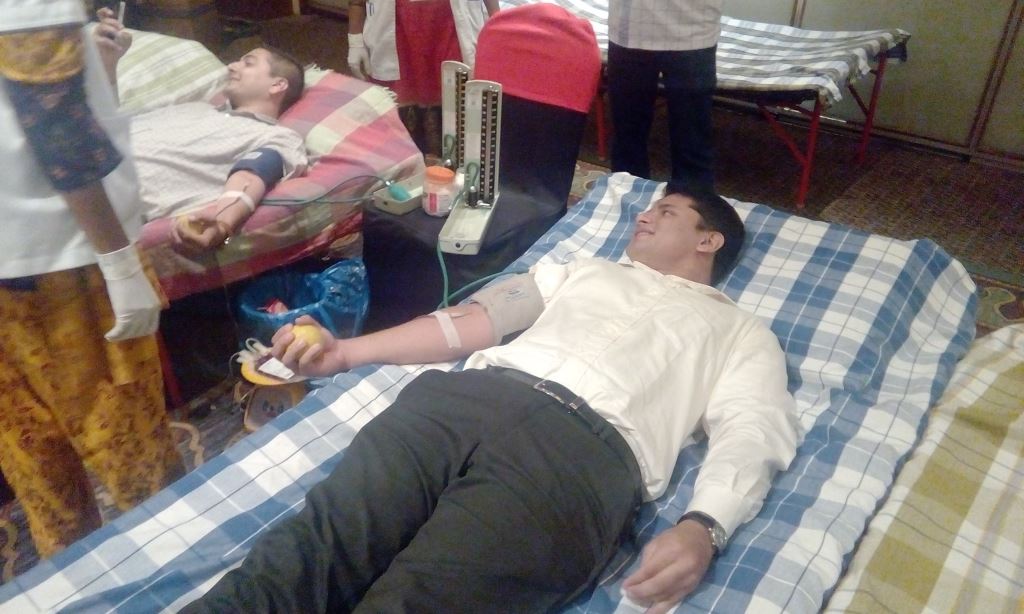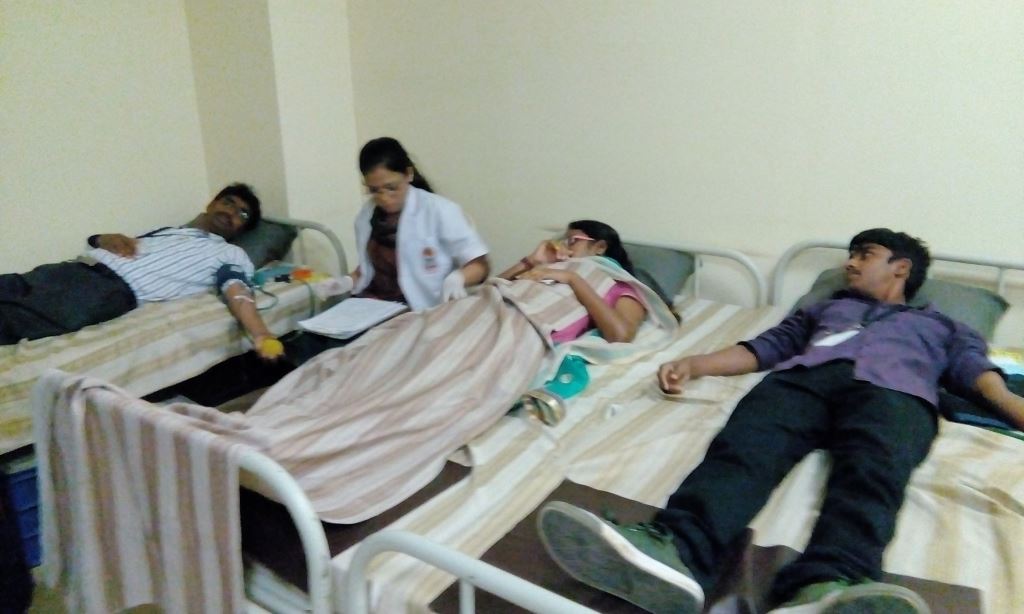Lesser camps, better planning for Rakta Kranti
Due to a patriotic fervour gripping the city around Independence day the number of blood donation drives in were far too many. At such times, Sankalp takes a stand not to organise too many drives. This ensures a balanced supply of blood without overloading and leading to possible wastage. Hence in the month of August, the team organised only 7 blood donation drives leading to a collection of 603 units of blood. The rate of adverse events was quite high compared to other months in the year and was about 4%. The introduction of the deferral protocol has shown some promising results. The donor screening was done on a more pragmatic basis. We had about 17.75% deferrals in the month. The first 15 days saw us organizing only 2 camps. A drive was organized on 1 August 2015 at Taj Vivanta. Enthusiastic employees of the hotel came forward in good numbers and eagerly waited for their chance to donate. 33 units were collected by Victoria Hospital. A drive at Tata Power on 12 August saw close to 100 employees coming in to donate. Plenty of donors who regularly donate in Sankalp camps were happy to be back again. Tata Power makes a significant contribution by organizing drives every 6 months. Post Independence Day the team organized 5 drives to cater to the needs towards the end of the month. A drive at Temenos saw 46 units collected by ESI Hospital. The drive at Idea Cellular saw 54 blood donor heroes donating to Bowring Hospital and young students of Azim Premji University also made their contribution by having 87 units donated to Victoria Hospital blood bank. Good publicity saw a fair share of people come forward in all these institutions.
Post Independence Day the team organized 5 drives to cater to the needs towards the end of the month. A drive at Temenos saw 46 units collected by ESI Hospital. The drive at Idea Cellular saw 54 blood donor heroes donating to Bowring Hospital and young students of Azim Premji University also made their contribution by having 87 units donated to Victoria Hospital blood bank. Good publicity saw a fair share of people come forward in all these institutions.
 Sankalp also connected to Huawei Technologies this month. A blood donation drive there saw more than 200 donors turned up. Constant flow of donors throughout the day saw 180 units collected by Rashtrothana blood bank. The units collected was of immense help to our thalassemia kids at our Samraksha centre. Our final drive of the month was at AIG where again really good education and motivation saw more than 30% of the employees form a bee line at the camp. 131 units were finally collected by Narayana Hrudayalaya blood bank.
Sankalp would like to thank the support of all these organizations for their support to the cause of voluntary blood donation.
Sankalp also connected to Huawei Technologies this month. A blood donation drive there saw more than 200 donors turned up. Constant flow of donors throughout the day saw 180 units collected by Rashtrothana blood bank. The units collected was of immense help to our thalassemia kids at our Samraksha centre. Our final drive of the month was at AIG where again really good education and motivation saw more than 30% of the employees form a bee line at the camp. 131 units were finally collected by Narayana Hrudayalaya blood bank.
Sankalp would like to thank the support of all these organizations for their support to the cause of voluntary blood donation.
Thalassemia Management and Care
August turned out to be an exceptionally busy month at Indira Gandhi Institute of Child Health. There were 236 patient visits with a total of 319 transfusions. The capacity of the centre is being utilized fully and is being stretched. Thanks to plenty of blood being available in the city we had blood units which were 5 days old on an average being given to the patients with 2 hours of processing time. This was inspite of 1 in 6 units of blood being organised from blood banks outside the institute. However, thanks to the sheer quantum of transfusions, scheduling became difficult and the average pre-transfusion Hb fell to 8.17 gm/dl. Median hospitalisation duration continued to hover at 7 hours. The centre also completed the annual cardiac screening, thanks to Jayadeva Institute of Cardiology. Three children need special attention so far as their cardiac health is concerned and they are being offered the same. Inspite of the ever increasing workload and the stress due to capacity vs. demand, the team is committed to ensuring that each child receives the best treatment. Project Samraksha had 191 visits with 236 units transfused in the month of August. However, generously contributing to the hustle bustle at the centre are the pre-transplant and post-transplant follow-ups. Like always, Rashtrotthana blood bank made available all needed units with average age of blood units being 5 days old and the processing time being 3 hours. The overall hospitalisation was 7 hours. The centre has been able to do a great job maintaining the pre-transfusion hemoglobin levels at 9gm/dl. The centre made good progress with the DEXA scans and also initiated cardio-vascular screening. The team at Samraksha is putting in intense effort to early identify the first signs of complications and build capacity to initiate corrective actions. As many transplanters would agree, most of the work which contributes to the success of bone marrow transplantations happens at the thalassemia centres. We had a capacity building program where there was discussion on how to ensure that the children who are undertaking management are maintained in best possible shape once they find a match. It’s true that the outcome of BMT depends upon the physiological status of the child including the ferritin level, the liver size and the spleen size etc. However, what is also true is that using proper therapy, the damage caused to the body can be reversed and the child can be brought from higher risk to lower risk categories prior to proceeding for transplants. with this intention, our teams geared up for state of the art down-staging program and collaboration with the transplant teams. In addition, the post transplant followup is also more effective if done in the friendly and more familiar environment of the day care centre rather than the hospitals themselves. With this intention, steps are being taken to ensure that the child who undertake BMT with Sankalp’s support continue to receive best care post transplant through the day care centres.The Emergency Team and the Blood Help-line
The blood help-line has consistently been receiving 30-60 blood requests and a total call load of about 100 calls per day(not to forget the 20% requests which come in the middle of the night). With such busy schedules, when an unfortunate event takes away the person who is managing the calls on the help-line number for the day, it amounts to a very difficult day for the volunteers. August was one such month. On one hand the city was desperately seeking platelet and on the other hand we had difficulty organising for people to manage calls. Then Akshata, the new Response Centre Executive came in. she picked up he task at hand very quickly and learnt the intricacies of differentiating between blood requests and providing appropriate solutions. Now, not only dies she take the regular blood requests which can be handled with the blood stocks in the blood banks, she has also been taking care of requests which require donors, single donor platelets and even some rare blood groups. The option of getting informed advice on a single call when it comes to need of blood is a very string asset. The information available through the help-line is become more elaborate and situationally accurate. With the option of reaching out to the help-line on a call, almost anyone can seek assistance.Patrika Edition
Patrika Section
Disqus Comment
